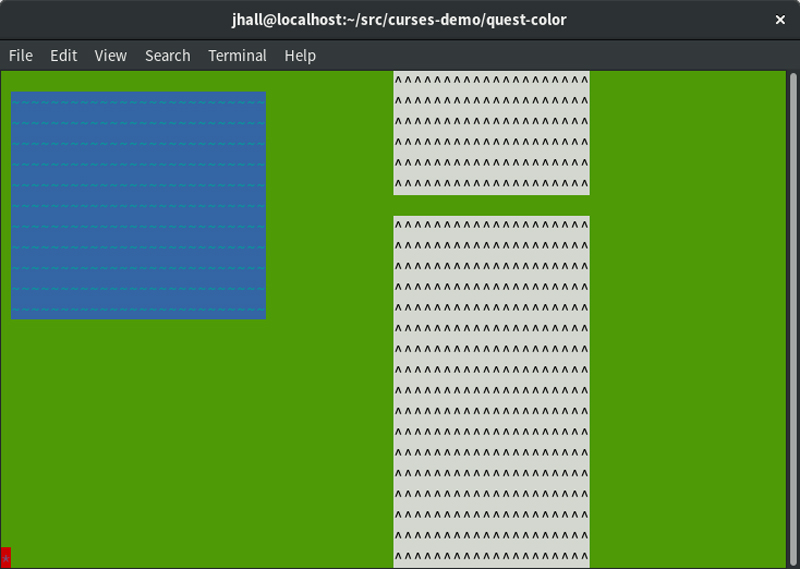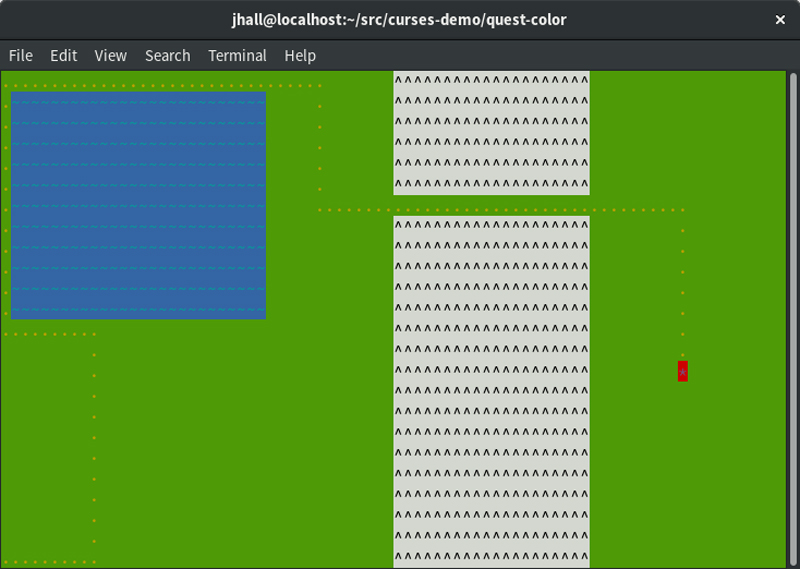

curses by adding colors to his terminal adventure
game. By Jim Hall
In parts one
and two
of my article series about programming with the ncurses
library, I introduced a few curses functions to draw text on the screen,
query characters from the screen and read from the keyboard. To demonstrate
several of these functions, I created a simple adventure game in
curses that
drew a game map and player character using simple characters. In this
follow-up article, I show how to add color to a curses program.
Drawing on the screen is all very well and good, but if it's all white-on-black text, your program might seem dull. Colors can help convey more information—for example, if your program needs to indicate success or failure. In such a case, you could display text in green or red to help emphasize the outcome. Or, maybe you simply want to use colors to "snazz" up your program to make it look prettier.
In this article, I use a simple example to demonstrate color manipulation via the
curses functions. In my previous article, I wrote a basic adventure-style
game that lets you move a player character around a crudely drawn map.
However, the
map was entirely black and white text, relying on shapes to suggest water (~)
or mountains (^), so let's update the game to use colors.
Before you can use colors, your program needs to know if it can rely on the terminal to display the colors correctly. On modern systems, this always should be true. But in the classic days of computing, some terminals were monochromatic, such as the venerable VT52 and VT100 terminals, usually providing white-on-black or green-on-black text.
To query the terminal
capability for colors, use the has_colors() function. This will return a true
value if the terminal can display color, and a false value if not. It is
usually used to start an if block, like this:
if (has_colors() == FALSE) {
endwin();
printf("Your terminal does not support color\n");
exit(1);
}
Having determined that the terminal can display color, you then can set up
curses
to use colors with the start_color() function. Now you're ready to define
the colors your program will use.
In curses, you define colors in pairs: a foreground color on a background
color. This allows curses to set both color attributes at once,
which often is what you want to do. To establish a color pair, use
init_pair() to
define a foreground and background color, and associate it to an index
number. The general syntax is:
init_pair(index, foreground, background);
Consoles support only eight basic colors: black, red, green, yellow, blue, magenta, cyan and white. These colors are defined for you with the following names:
COLOR_BLACK
COLOR_RED
COLOR_GREEN
COLOR_YELLOW
COLOR_BLUE
COLOR_MAGENTA
COLOR_CYAN
COLOR_WHITEIn my adventure game, I'd like the grassy areas to be green and the player's "trail" to be a subtle yellow-on-green dotted path. Water should be blue, with the tildes in the similar cyan color. I'd like mountains to be grey, but black text on a white background should make for a reasonable compromise. To make the player's character more visible, I'd like to use a garish red-on-magenta scheme. I can define these color pairs like so:
start_color();
init_pair(1, COLOR_YELLOW, COLOR_GREEN);
init_pair(2, COLOR_CYAN, COLOR_BLUE);
init_pair(3, COLOR_BLACK, COLOR_WHITE);
init_pair(4, COLOR_RED, COLOR_MAGENTA);
To make my color pairs easy to remember, my program defines a few symbolic constants:
#define GRASS_PAIR 1
#define EMPTY_PAIR 1
#define WATER_PAIR 2
#define MOUNTAIN_PAIR 3
#define PLAYER_PAIR 4
With these constants, my color definitions become:
start_color();
init_pair(GRASS_PAIR, COLOR_YELLOW, COLOR_GREEN);
init_pair(WATER_PAIR, COLOR_CYAN, COLOR_BLUE);
init_pair(MOUNTAIN_PAIR, COLOR_BLACK, COLOR_WHITE);
init_pair(PLAYER_PAIR, COLOR_RED, COLOR_MAGENTA);
Whenever you want to display text using a color, you just need to tell
curses to
set that color attribute. For good programming practice, you also should tell
curses to undo the color combination when you're done using the
colors. To set
the color, use attron() before calling functions like
mvaddch(), and then turn
off the color attributes with attroff() afterward. For example, when I draw
the player's character, I might do this:
attron(COLOR_PAIR(PLAYER_PAIR));
mvaddch(y, x, PLAYER);
attroff(COLOR_PAIR(PLAYER_PAIR));
Note that applying colors to your programs adds a subtle change to how you
query the screen. Normally, the value returned by mvinch() is of
type chtype.
Without color attributes, this is basically an integer and can be used as
such. But, colors adds extra attributes to the characters on the screen, so
chtype carries extra color information in an extended bit
pattern. If you use
mvinch(), the returned value will contain this extra color value. To extract
just the "text" value, such as in the is_move_okay() function,
you
need to apply a bitwise and with the A_CHARTEXT bit mask:
int is_move_okay(int y, int x)
{
int testch;
/* return true if the space is okay to move into */
testch = mvinch(y, x);
return (((testch & A_CHARTEXT) == GRASS)
|| ((testch & A_CHARTEXT) == EMPTY));
}
With these changes, I can update the adventure game to use colors:
/* quest.c */
#include <curses.h>
#include <stdlib.h>
#define GRASS ' '
#define EMPTY '.'
#define WATER '~'
#define MOUNTAIN '^'
#define PLAYER '*'
#define GRASS_PAIR 1
#define EMPTY_PAIR 1
#define WATER_PAIR 2
#define MOUNTAIN_PAIR 3
#define PLAYER_PAIR 4
int is_move_okay(int y, int x);
void draw_map(void);
int main(void)
{
int y, x;
int ch;
/* initialize curses */
initscr();
keypad(stdscr, TRUE);
cbreak();
noecho();
/* initialize colors */
if (has_colors() == FALSE) {
endwin();
printf("Your terminal does not support color\n");
exit(1);
}
start_color();
init_pair(GRASS_PAIR, COLOR_YELLOW, COLOR_GREEN);
init_pair(WATER_PAIR, COLOR_CYAN, COLOR_BLUE);
init_pair(MOUNTAIN_PAIR, COLOR_BLACK, COLOR_WHITE);
init_pair(PLAYER_PAIR, COLOR_RED, COLOR_MAGENTA);
clear();
/* initialize the quest map */
draw_map();
/* start player at lower-left */
y = LINES - 1;
x = 0;
do {
/* by default, you get a blinking cursor - use it to
indicate player * */
attron(COLOR_PAIR(PLAYER_PAIR));
mvaddch(y, x, PLAYER);
attroff(COLOR_PAIR(PLAYER_PAIR));
move(y, x);
refresh();
ch = getch();
/* test inputted key and determine direction */
switch (ch) {
case KEY_UP:
case 'w':
case 'W':
if ((y > 0) && is_move_okay(y - 1, x)) {
attron(COLOR_PAIR(EMPTY_PAIR));
mvaddch(y, x, EMPTY);
attroff(COLOR_PAIR(EMPTY_PAIR));
y = y - 1;
}
break;
case KEY_DOWN:
case 's':
case 'S':
if ((y < LINES - 1) && is_move_okay(y + 1, x)) {
attron(COLOR_PAIR(EMPTY_PAIR));
mvaddch(y, x, EMPTY);
attroff(COLOR_PAIR(EMPTY_PAIR));
y = y + 1;
}
break;
case KEY_LEFT:
case 'a':
case 'A':
if ((x > 0) && is_move_okay(y, x - 1)) {
attron(COLOR_PAIR(EMPTY_PAIR));
mvaddch(y, x, EMPTY);
attroff(COLOR_PAIR(EMPTY_PAIR));
x = x - 1;
}
break;
case KEY_RIGHT:
case 'd':
case 'D':
if ((x < COLS - 1) && is_move_okay(y, x + 1)) {
attron(COLOR_PAIR(EMPTY_PAIR));
mvaddch(y, x, EMPTY);
attroff(COLOR_PAIR(EMPTY_PAIR));
x = x + 1;
}
break;
}
}
while ((ch != 'q') && (ch != 'Q'));
endwin();
exit(0);
}
int is_move_okay(int y, int x)
{
int testch;
/* return true if the space is okay to move into */
testch = mvinch(y, x);
return (((testch & A_CHARTEXT) == GRASS)
|| ((testch & A_CHARTEXT) == EMPTY));
}
void draw_map(void)
{
int y, x;
/* draw the quest map */
/* background */
attron(COLOR_PAIR(GRASS_PAIR));
for (y = 0; y < LINES; y++) {
mvhline(y, 0, GRASS, COLS);
}
attroff(COLOR_PAIR(GRASS_PAIR));
/* mountains, and mountain path */
attron(COLOR_PAIR(MOUNTAIN_PAIR));
for (x = COLS / 2; x < COLS * 3 / 4; x++) {
mvvline(0, x, MOUNTAIN, LINES);
}
attroff(COLOR_PAIR(MOUNTAIN_PAIR));
attron(COLOR_PAIR(GRASS_PAIR));
mvhline(LINES / 4, 0, GRASS, COLS);
attroff(COLOR_PAIR(GRASS_PAIR));
/* lake */
attron(COLOR_PAIR(WATER_PAIR));
for (y = 1; y < LINES / 2; y++) {
mvhline(y, 1, WATER, COLS / 3);
}
attroff(COLOR_PAIR(WATER_PAIR));
}
Unless you have a keen eye, you may not be able to spot all of the changes
necessary to support color in the adventure game. The diff tool shows all
the instances where functions were added or code was changed to support
colors:
$ diff quest-color/quest.c quest/quest.c
12,17d11
< #define GRASS_PAIR 1
< #define EMPTY_PAIR 1
< #define WATER_PAIR 2
< #define MOUNTAIN_PAIR 3
< #define PLAYER_PAIR 4
<
33,46d26
< /* initialize colors */
<
< if (has_colors() == FALSE) {
< endwin();
< printf("Your terminal does not support color\n");
< exit(1);
< }
<
< start_color();
< init_pair(GRASS_PAIR, COLOR_YELLOW, COLOR_GREEN);
< init_pair(WATER_PAIR, COLOR_CYAN, COLOR_BLUE);
< init_pair(MOUNTAIN_PAIR, COLOR_BLACK, COLOR_WHITE);
< init_pair(PLAYER_PAIR, COLOR_RED, COLOR_MAGENTA);
<
61d40
< attron(COLOR_PAIR(PLAYER_PAIR));
63d41
< attroff(COLOR_PAIR(PLAYER_PAIR));
76d53
< attron(COLOR_PAIR(EMPTY_PAIR));
78d54
< attroff(COLOR_PAIR(EMPTY_PAIR));
86d61
< attron(COLOR_PAIR(EMPTY_PAIR));
88d62
< attroff(COLOR_PAIR(EMPTY_PAIR));
96d69
< attron(COLOR_PAIR(EMPTY_PAIR));
98d70
< attroff(COLOR_PAIR(EMPTY_PAIR));
106d77
< attron(COLOR_PAIR(EMPTY_PAIR));
108d78
< attroff(COLOR_PAIR(EMPTY_PAIR));
128,129c98
< return (((testch & A_CHARTEXT) == GRASS)
< || ((testch & A_CHARTEXT) == EMPTY));
---
> return ((testch == GRASS) || (testch == EMPTY));
140d108
< attron(COLOR_PAIR(GRASS_PAIR));
144d111
< attroff(COLOR_PAIR(GRASS_PAIR));
148d114
< attron(COLOR_PAIR(MOUNTAIN_PAIR));
152d117
< attroff(COLOR_PAIR(MOUNTAIN_PAIR));
154d118
< attron(COLOR_PAIR(GRASS_PAIR));
156d119
< attroff(COLOR_PAIR(GRASS_PAIR));
160d122
< attron(COLOR_PAIR(WATER_PAIR));
164d125
< attroff(COLOR_PAIR(WATER_PAIR));
The program now has a more pleasant color scheme, more closely matching the original tabletop gaming map, with green fields, blue lake and imposing gray mountains. The hero clearly stands out in red and magenta livery.

Figure 1. A Simple Tabletop Game Map, with a Lake and Mountains

Figure 2. The player starts the game in the lower-left corner.

Figure 3. The player can move around the play area, such as around the lake, through the mountain pass and into unknown regions.
With colors, you can represent information more clearly. This simple
example uses colors to indicate playable areas (green) versus impassable
regions (blue or gray). I hope you will use example game as a starting point or reference for
your own programs. You can do so much more with curses, depending on what you
need your program to do.
In a follow-up article, I plan to demonstrate other
features of the ncurseslibrary, such as how to create windows and frames. In
the meantime, if you are interested in learning more about curses, I
encourage you to read Pradeep Padala's NCURSES Programming
HOWTO, at the
Linux Documentation Project.
Jim Hall is an advocate for free and open-source software, best known for his work on the FreeDOS Project, and he also focuses on the usability of open-source software. Jim is the Chief Information Officer at Ramsey County, Minn.